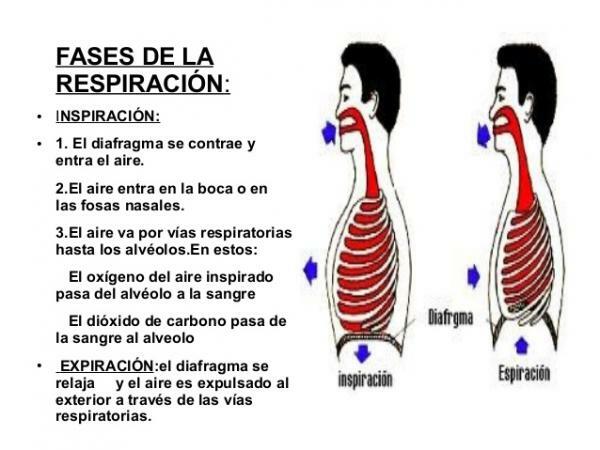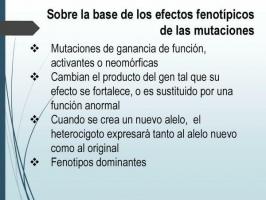Phases of BREATH: inspiration and expiration

Image: Slideshare
One of the most important processes for living beings it is respiration. In fact, human beings breathe approximately twelve to twenty times per minute and it is one of many systems with involuntary and automatic control.
Respiration is a gas exchange process in which oxygen is taken in and waste substances, mainly carbon dioxide, are removed. Based on their definition, they are usually distinguished two phases of respiration human: the inspiration and expiration. If you want to know more about these two phases, we invite you to continue reading this lesson from a TEACHER!
Respiration can be defined as thegas exchange process between the external environment and the internal human environment, whereby oxygen is taken in and carbon dioxide removed.
At first glance this process may be easy but it is made up of different steps or stages, all of them important and in which different structures, cell types, etc. are involved. To study respiration, this process is divided into two great stages: the inspiration or inhalation and expiration or exhalation.
- During inhalation, gases enter the body, mainly oxygen
- During exhalation there is a cellular debris output in the form of gases, mainly carbon dioxide, but also other gases such as those produced during the metabolism of alcohol (allowing airborne detection of the BAC) or during the metabolism of some drugs.
The first of the phases of respiration or respiratory cycle is the inspiration or inhalation. This phase can be defined as a part active muscle of respiration, in which the expansion of the rib cage and air intake from the external environment to the interior of the lung.
Seen like this, this can be very simple, but for oxygen to reach each of our cells, different steps have to take place correctly and sequentially:
- The diaphragm muscle contracts. The diaphragm is a muscle under the lungs, between the lungs and the organs of the abdomen. The contraction of the diaphragm downwards creates a vacuum that will leave room for the expansion of the rib cage.
- The rib cage expands. The rib cage has the ability to extend due to the anatomical and structural characteristics of the rib cage, which give it a certain elasticity. By leaving enough room for the lowering of the diaphragm, the rib cage expands not only downward but also outward. This expansion together with the entry of air into the lungs will be what causes their filling.
- Lungs expand. The lungs have become attached to the rib cage, so the movement of the rib cage causes the lungs to also expand or distend. When these swell, to fill that space, the nose or mouth generates a suction movement to capture the air that fills those lungs.
- Air passes from the external environment to the lungs. The air sucked from the external environment passes through the trachea to the bronchi and the brachial tree and enters the tiny alveolar sacs. In this way, the air enters each of the cells in the lungs.
- Passing of oxygen into the bloodstream. The lungs have a large number of blood vessels, which are grouped especially around the alveolar sacs since it is in these structures that gas exchange occurs. The pulmonary alveoli are full of gases that have entered from the outside, but it is only oxygen that crosses, through the walls of the blood capillaries, to the red blood cells. Red blood cells, thanks to a protein called hemoglobin, is capable of taking these oxygen molecules and carrying them to all the tissues of our body through the blood.
The second phase of breathing is the expiration or exhalation. Exhalation is a stage passive, without muscular activity, in which the air leaves the lung cavity to the external environment through the chest cavity contraction. The air release occurs not the relaxation of the inspiratory musculature and the elastic recovery of the lungs previously distended on inspiration, that is, the muscles do not contract actively.
During expiration, 5 steps can also be differentiated:
- Carbon dioxide passes from tissues to blood vessels. The gases produced by cells during their activity, mainly carbon dioxide, pass into the blood vessels by simple transport mechanisms. The gases, which are found in higher concentration within the tissues, pass through the permeable walls of the capillaries.
- Waste substances reach the lungs. The blood carries the substances to the lungs, which are still full due to inspiration. These gases pass through the walls of the alveoli and pass into the trapped air.
- The diaphragm relaxes. Contraction of the diaphragm stops and the diaphragm relaxes
- Contraction of the rib cage. The diaphragm relaxes and returns to its place. This reduces the available volume and therefore the volume of the rib cage decreases. The rib cage contracts and the pressure inside it increases.
- Lung emptying. The increase in pressure within the rib cage and its contraction causes air to escape from the lung, which deflates and causes air to escape through the windpipe, which carries this air to the mouth or nose.
As you have seen, respiration is not produced solely by the action of the respiratory system or the lungs, but there are many structures involved (like the trachea) or even other complete systems (like the cardiovascular system).
For each of the phases of respiration to occur properly the respiratory muscles must be activated in the right way and time, the movements and pressures within the system have to be the right ones and the different structures have to have elastic resistance, air resistance and elasticity optimal. Orchestrating all this is quite complicated so there may be different failures that generate pathological states or diseases such as bronchitis, asthma, etc.


